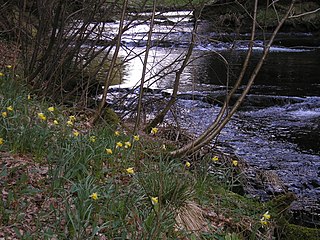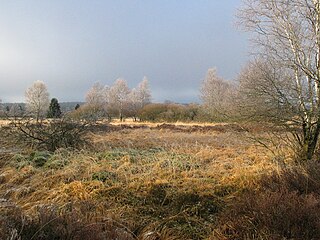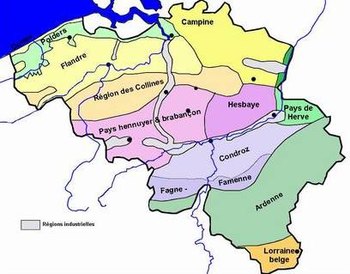
Hainaut, historically also known as Heynault in English, is the westernmost province of Wallonia, the French-speaking region of Belgium.

Couvin is a city and municipality of Wallonia located in the province of Namur, Belgium.

Philippeville is a city and municipality of Wallonia located in the province of Namur, Belgium. The Philippeville municipality includes the former municipalities of Fagnolle, Franchimont, Jamagne, Jamiolle, Merlemont, Neuville, Omezée, Roly, Romedenne, Samart, Sart-en-Fagne, Sautour, Surice, Villers-en-Fagne, Villers-le-Gambon, and Vodecée.

The Vesdre, Weser or Vesder is a river in Liège Province, eastern Belgium.

The Amblève or Amel is a 93-kilometre (58 mi) long river in eastern Belgium in the province of Liège. It is a right tributary of the river Ourthe. It rises near Büllingen in the High Fens or Hoge Venen (Dutch), Hohes Venn (German), and Hautes Fagnes (French), close to the border with Germany.

The High Fens, which were declared a nature reserve in 1957, are an upland area, a plateau region in Liège Province, in the east of Belgium and adjoining parts of Germany, between the Ardennes and the Eifel highlands. The High Fens are the largest nature reserve or park in Belgium, with an area of 4,501.2 ha ; it lies within the German-Belgian natural park Hohes Venn-Eifel, in the Ardennes. Its highest point, at 694 metres (2,277 ft) above sea level, is the Signal de Botrange near Eupen, and also the highest point in Belgium. A tower 6 metres (20 ft) high was built here that reaches 700 metres (2,297 ft) above sea level. The reserve is a rich ecological endowment of Belgium covered with alpine sphagnum raised bogs both on the plateau and in the valley basin; the bogs, which are over 10,000 years old, with their unique subalpine flora, fauna and microclimate, are key to the conservation work of the park.
Moustier or Moustiers is the name or part of the name of several communes in France and Belgium:

The Warche is a river in eastern Belgium.
Didier Comès was a Belgian comics artist, best known for his graphic novels published in the magazine (À Suivre).

Wallers-en-Fagne is a commune in the Nord department in northern France.

Moustier-en-Fagne is a commune in the Nord department in northern France.
Fagne or Fagnes can refer to:

Fagnolle Castle is a castle located in the district of Fagnolle, in the municipality of Philippeville, Wallonia, Belgium, and in the Fagne region. The castle was formerly the centre of government of the small independent Barony, later County, of Fagnolle. It was constructed in the 12th century, and is now ruined.

The Belgian Eifel in the German-speaking part of Belgium generally refers to the southern part of the German-speaking community which forms the Canton of Sankt Vith. According to this definition the municipalities of Amel, Büllingen, Burg-Reuland, Bütgenbach and Sankt Vith belong to the Belgian Eifel. This very rural area is very sparsely populated, unlike the northern part of the German-speaking community, Eupener Land.

The German-Belgian High Fens – Eifel Nature Park, often called the North Eifel Nature Park, is a cross-border nature park with elements in the German federal states of North Rhine-Westphalia and Rhineland-Palatinate as well as the Belgian province of Liège. It has a total area of 2,485 km2 (959 sq mi).

The Fagne or la Fagne is a natural region in southern Belgium and northern France, sometimes grouped with Famenne as Fagne-Famenne. It should not be confused with the High Fens, which are further east and straddle the border of Belgium and Germany.

Famenne is a natural region in Wallonia. Together with The Fagne or la Fagne, west of the river Meuse, it is part of the Fagne-Famenne natural region. The two regions are often grouped together because they are quite similar both geographically and naturally.

Fagne-Famenne is a natural region in southern Belgium and northern France. It consists of The Fagne or la Fagne west of the river Meuse, and Famenne to the east. The two regions are often grouped together because they are quite similar both geographically and naturally.
The Lomme gau or pagus, often referred to using Latin, Pagus Lomacensis, or German Lommegau, was an early Austrasian Frankish territorial division. The oldest Latin spellings were Laumensis or Lomensis. It included the city of Namur, and the region where the County of Namur later came to form in the 10th century.

Boussu-en-Fagne is a village of Wallonia and a district of the municipality of Couvin, located in the province of Namur, Belgium.
















